Thaipusam the Murugan Festival
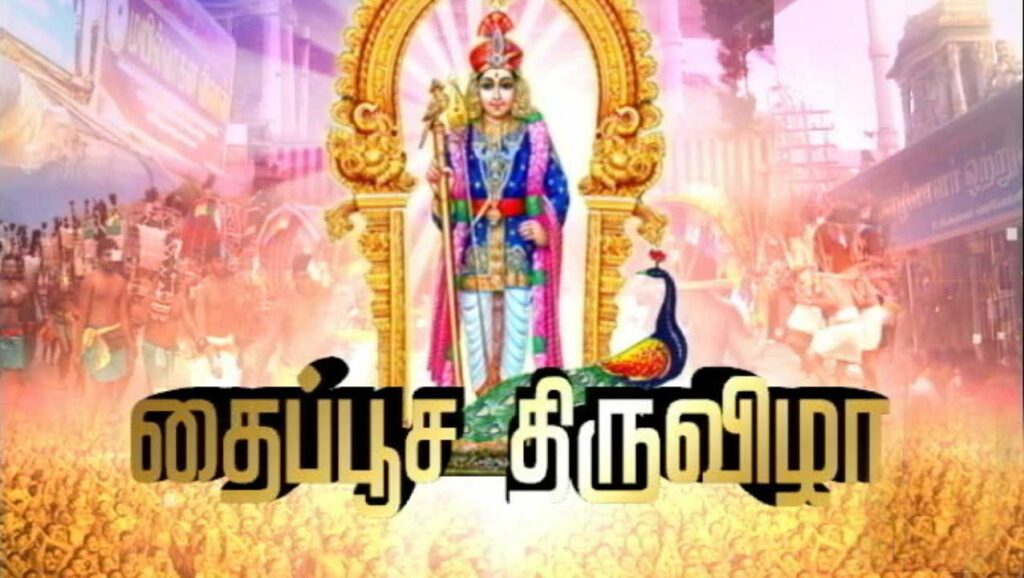
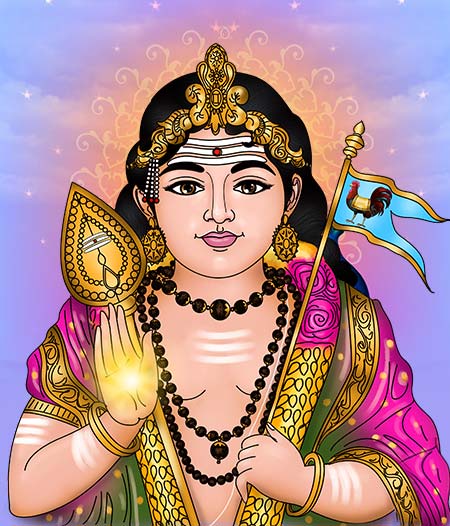
By Subhamoy Das
Thaipusam is an important festival observed by the Hindus of southern India during the Tamil month of Thai (January – February). Outside of India, it is celebrated mainly by the Tamil speaking community settled in Malaysia, Singapore, South Africa, Sri Lanka and elsewhere around the world.
Dedicated to Lord Murugan or Kārttikeya
Thaipusam is dedicated to the Hindu god Murugan, the son of Shiva and Parvati. Murugan is also known as Kārttikeya, Subrahmanya, Sanmukha, Shadanana, Skanda and Guha. It is believed that on this day, Goddess Parvati presented a lance to Lord Murugan to vanquish the demon army of Tarakāsura and combat their evil deeds. Therefore, Thaipusam is a celebration of the victory of good over evil.
Thaipusam is celebrated during the full moon in the Tamil month of Thai and commemorates the birthday of the Hindu deity Murugan. To mark this day of penance and thanksgiving, Hindus pierce their body with metal skewers and carry pots of milk on their heads along a four kilometre procession.
How to Celebrate Thaipusam
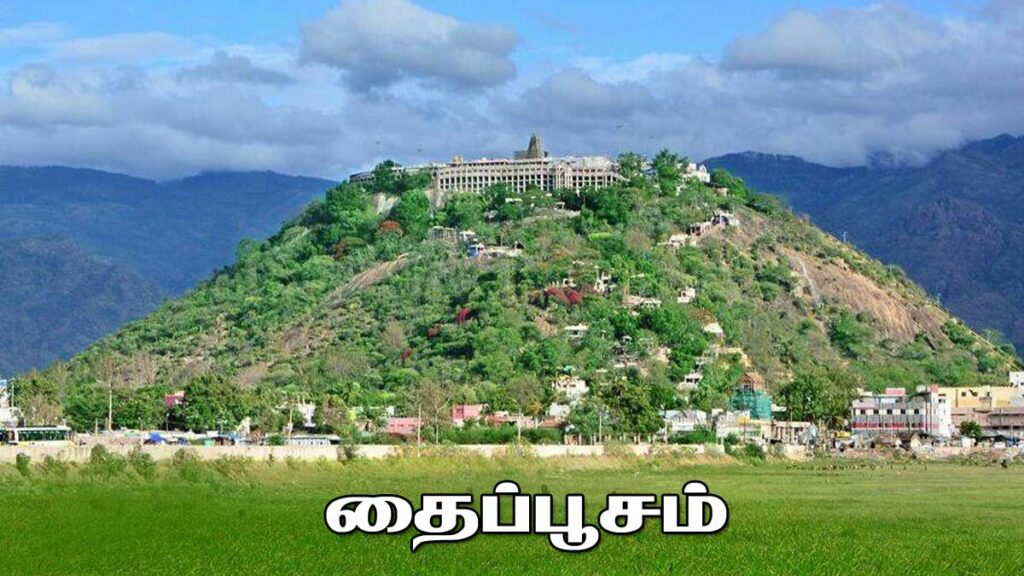
On the Thaipusam day, most devotees of Lord Murugan offer him fruits and flowers of yellow or orange color – his favorite colors and also adorn dresses of the same color.
Many devotees bear milk, water, fruits and floral tributes on pails hung from a yoke and carry them on their shoulders to various Murugan temples, far and near. This wooden or bamboo structure called ‘Kavadi’ is covered with cloth and decorated with feathers of peacock – the vehicle of Lord Murugan.
Thaipusam in Southeast Asia
Thaipusam celebrations in Malaysia and Singapore are known for their festive fervor. The most famous Kavadi pilgrimage on the Thaipusam day takes place at the Batu Caves in Malaysia, where a large number of devotees head towards the Murugan temple in procession carrying the ‘Kavadi’.
This festival attracts over a million people each year at the Batu Caves, near Kuala Lampur, which houses several Hindu shrines and the 42.7 meter high statue of Lord Murugan that was unveiled in January 2006.
Pilgrims need to climb 272 steps to access the temple on the hilltop. Many foreigners also take part in this Kavadi pilgrimage. Notable among them are Australian Carl Vedivella Belle and German Rainer Krieg, who have been attending Thai Poosam festival and taking Kavadi at Batu Caves, Malaysia since the 1970s.
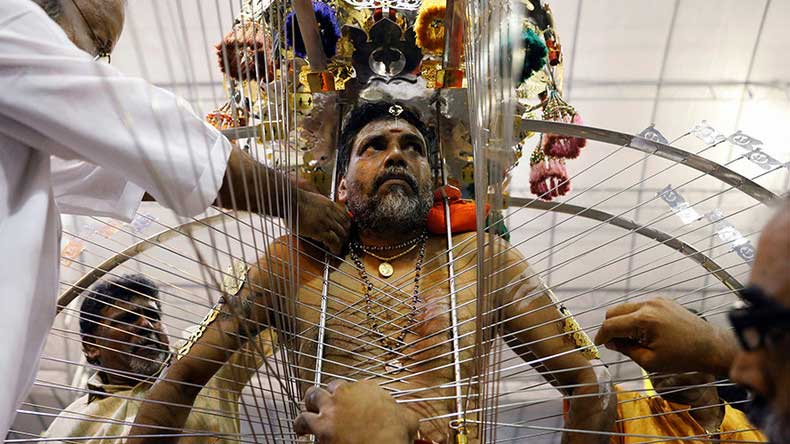
Body Piercing on Thaipusam
Many fanatical devotees go to such extent as to torture their bodies to appease the Lord. So, a major feature of Thaipusam celebrations is body piercing with hooks, skewers and small lances called ‘vel’.
Many of these devotees even pull chariots and heavy objects with hooks attached to their bodies. Many others pierce their tongue and cheek to impede speech and thereby attain full concentration on the Lord. Most devotees enter into a trance during such piercing due to the incessant drumming and chanting of “vel vel shakti vel.”
Thaipusam Celebrations in Southeast Asia
Southeast Asia’s sizable Tamil Indian population celebrates Thaipusam, an annual feast to honor the Hindu god Subramaniam, or Murugan. A procession draws devotees and onlookers with the spectacle of thousands of devotees bearing sacrifices to the Lord Murugan.
The Lord Murugan is venerated as a granter of favors – if a wish is granted, supplicants repay the Lord through sacrifices like bearing the kavadi: a portable altar attached to the devotee by 108 vels, or metal skewers, pierced into the devotee’s skin!
Up to a week before the Thaipusam celebrations, kavadi bearers fast in preparation for the event. Then on the day of Thaipusam, they ask trusted relatives to pierce their cheeks, tongue, face, and other body parts with vels, then load a kavadi onto their shoulders before setting off on the devotional procession.
Kavadis are exquisitely beautiful works of religious art – decorated with peacock feathers, and garnished with aluminum plates bearing pictures of Hindu deities. Some kavadis weigh up to 33 pounds, skewers, feathers, and all – but kavadi bearers make a grand show of carrying the whole grisly ensemble down the parade route. Surprisingly, little to no blood is spilled throughout the procession.
Not all devotees carry kavadis to show their devotion to the Lord Murugan – other devotees join the procession bearing pots of milk called paal kudam, while couples who have been blessed with children over the past year will carry their babies in saffron slings suspended from sugarcane stalks.
Along the procession, thousands of fresh coconuts are smashed, another act of devotion to the Lord Murugan.
Thaipusam in Singapore
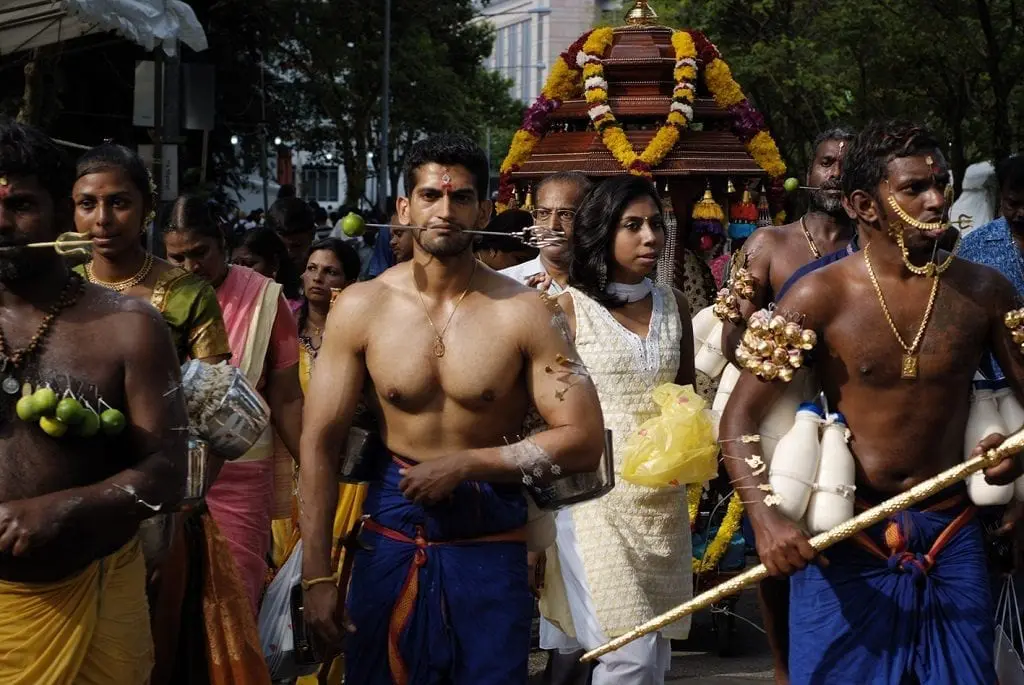
In Singapore, the festival is marked with a chariot procession that begins at the Sri Srinivasa Perumal Temple at 397 Serangoon Road in the Little India district.
Over 20,000 devotees will join a procession snaking through Little India’s Serangoon Road, Selegie Road, Prinsep Street, Penang Road and Clemenceau Avenue, concluding at Sri Thandayuthapani Temple on 15 Tank Road.
Thaipusam in Batu Caves, Malaysia
In Malaysia, the most famous Thaipusam celebration happens at the Batu Caves in Gombak District, Selangor.
These caves are composed of three main caves with a few smaller cavelets. To reach the top cave, visitors must climb 272 steps up to the cave opening.
While the cave is open year-round, its visitor profile reaches its height during Thaipusam, as more than a million people crowd to Batu Caves to witness the procession.
As early as 4 am, devotees set out from Sri Maha Mariamman Temple in Kuala Lumpur to tackle the eight-mile hike on foot. Leading the procession is a jeweled chariot bearing a statue of Lord Murugan, followed by devotees carrying kavadis and other sacrifices.
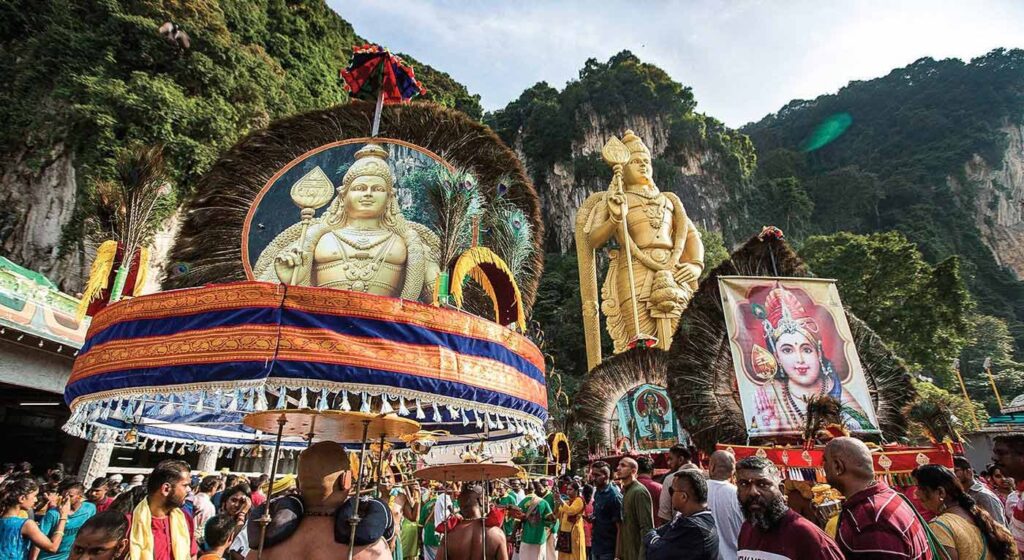
The procession takes eight hours to reach the Batu Caves. Devotees will then carry the image up the caves’ 272 steps, with the kavadi carriers following, assisted by friends and family. The sound of drums and flutes fill the air, as the procession participants join the music with shouts of “vel, vel, vel”.
Once the chariot has reached the cave, devotees leave their kavadis and other sacrifices at the feet of the image of the Lord Murugan.
Thaipusam Elsewhere in Malaysia
In Penang, Thaipusam is celebrated with a procession from the Nattukottai Chettiar Temple to the Arulmigu Balathandayuthapani hilltop temple.
In Johor Baru, various temples host Thaipusam processions.
In Ipoh, the Thaipusam procession begins at the Sri Mariamar Temple in Buntong, and ends at the Sri Subramaniam Temple in Gunung Cheroh.
Sources:
- Thaipusam Celebrations in Southeast Asia
- Hindu Thaipusam festival
